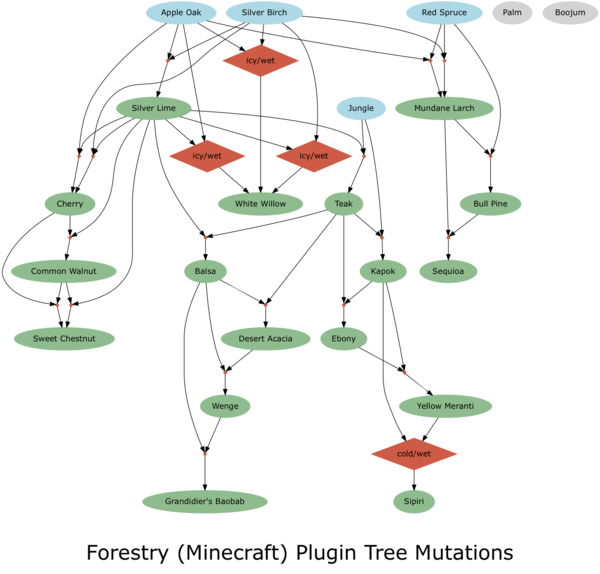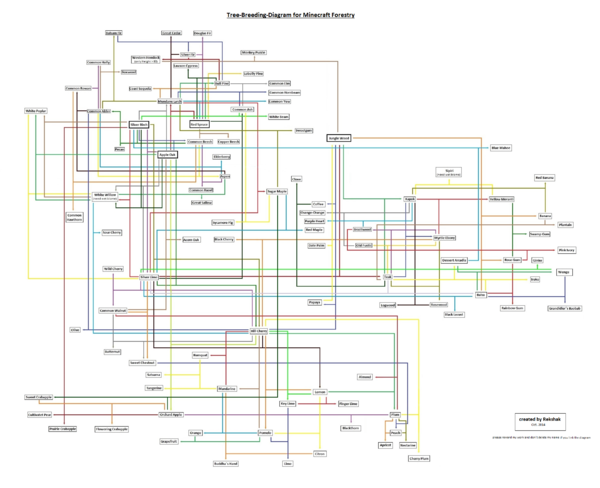ON THIS WIKI
Tutorial:Tree Basics (Arboriculture)
(Redirected from Tree Breeding)

|
This article is part of the Feed The Beast Wiki's Tutorials section. |
Tree Breeding or Arboriculture is a mechanic introduced by the Forestry mod. It allows the player to obtain new types of trees by cross pollinating trees with forestry Bees. These trees will give the player access to new types of wood and some will provide new fruits. The goal of this tutorial is to provide a step-by-step set of instructions for a player with no previous experience with Arboriculture.
Contents
[hide]Get Some Bees and Some Trees
To fully get into Tree Breeding, you are going to want to gather the six Vanilla trees: oak, birch, spruce, jungle, acacia trees, and dark oak. You will also want some bees; almost any bees will do but bees of a higher specific trait are more helpful. You can find out about bees and bee breeding in Bee Breeding and Bee Species.
If you have trees with genomes (vanilla ones that you've run through a treealyzer or ones you've bred with bees), they will start spawning butterflies. If you build your tree farm in such a way that the butterflies can't get out, the butterflies can technically do the fertilizing and you won't need bees, but butterflies are somewhat slower.
Where to Begin
You can start by running the vanilla saplings through a treealizer; this causes the Forestry mod to 'recognize' them, so that when you start breeding you'll get new species faster. You can also plant ordinary not-analyzed trees and let your bees go to work on them; the saplings they drop will be the Forestry saplings. The best thing to do with these saplings is place them in a mixed 'grove'; if you already know which trees you want and how to get them, you can place only the required trees in your grove, or you can go by blind luck.
You can place either Apiaries or Bee Houses between them, put a queen and drone in each of these, and the bees will start flying around and pollinating the trees. You can automate the apiaries or bee houses to make this go smoother, but it's not required. The bees generally need at least one flower around their housing. Bee houses are cheaper than apiaries and bees will live longer in them, but they cannot be automated where apiaries can.
After a while, the leaf blocks on the trees will become pollinated. Note that this takes time, you'll pass through several generations of bees before it happens; the Forestry mod requires patience for nearly everything. In order to see these pollinated blocks, you'll need Spectacles or an Apiarist's Hat; when you put these in the head armor slot in your inventory, you can see the pollinated leaf blocks as looking like leaves from different trees. If you break these leaf blocks with a Grafter, you'll be sure of a sapling drop (this does not seem to be working on any and all leaves anymore, just the pollinated ones). Grafters don't have a lot of uses before they break, so you'll need a good number of them.
When you have some new saplings, you can plant them in your grove (possibly after removing some of the old ones) and start over.
The Treealyzer
As mentioned above, running saplings through the Treealyzer converts them into saplings recognized by Forestry. It also allows you to examine saplings in detail; you can breed trees without using it, but this way any mutations would largely be a matter of luck, and selective breeding would be very time consuming. If you place a sapling and a Honey Drop or Honeydew into their respective slot, its full genetic makeup will be given.
Honey isn't easy to come by, as bees don't always generate a Honey Comb before they die. If you want to crossbreed your bees as well, you can use Cultivated Bees, the fastest workers, or bees from the Noble branch, which produce Dripping Combs. These combs have a 100% chance of dropping Honeydew in the Centrifuge, alongside a 40% chance of Honey Drops.
The Grafter
The Grafter can be crafted in a crafting grid as follows:
Alternatively a Proven Grafter can be obtained by trading with villagers.
Automated Apiary Construction
Set up any old automated apiary (generally consisting of an Apiary, Wooden Pipe, Autarchic Gate/Redstone Engine, and a pipe to sort the bees and combs). You can make as many apiaries as you want to cover the entirety of your grove, and you can use them as an automated honey producer as well!
Getting Established
So you have a ton of new trees, but you don't have the kind you want, keep going! Be sure to take out the trees from your grove that have already produced all of the kinds of new trees that they will produce.
Trees
- Balsa
- Balsa trees are large, 1x1 trees with straight trunks, light colored wood, and very few leaves.
- Bull Pine
- the Bull Pine tree is a variant of the Spruce tree commonly found in vanilla Minecraft. Its leaves are much yellower, however. It produces vanilla Spruce planks, which makes it the only forestry tree which does not have its own unique type of wood.
- Common Walnut
- Common Walnut trees are average height, 2x2 trees with dark wood. They produce walnuts, which can be squeezed to make seed oil.
- Desert Acacia
- Desert Acacia trees are small 1x1 trees which produce no fruit and have green wood. They have a shallow pyramid shaped canopy, and look almost identical to ExtraBiomesXL's Acacia trees.
- Grandidier's Baobab
- Grandidier's Baobab trees are large, fruitless, 3x3 trees with green planks and reddish bark.
- Hill Cherry
- Hill Cherry trees are small 1x1 trees with yellow wood, red bark, and purple leaves. They produce cherries, which can currently only be used to make seed oil in a squeezer.
- Kapok
- Kapok trees are very tall 1x1 trees which have a cluster of leaves at the top, produce no fruit, and have a tan colored wood.
- Mundane Larch
- Mundane Larch trees are one of the first trees you will discover, as they are bred from vanilla trees. they are average height 1x1 trees, and produce pink colored wood.
- Myrtle Ebony
- Myrtle Ebony trees are average height 3x3 trees. They produce no fruit, and have a very dark colored wood, with a light colored bark.
- Sequoia
- Sequoia tree are very tall 3x3 trees which produce relatively few leaves. They have no fruit, and a reddish color wood.
- Silver Lime
- Silver lime trees are short, fruitless, 1x1 trees which have a yellowish wood. Apiarist houses in NPC villages are usually made of lime wood planks.
- Sipiri
- Sipiri trees are tall, 1x1 trees. They will not grow in any biome except a jungle or mini-jungle, which makes them the only Forestry tree which currently cannot grow outside its specified biome. It produces Greenheart wood, and is one of only two trees from forestry, the other being the Yellow Meranti, which have wood that is named differently than the tree which produces it.
- Sweet Chestnut
- Sweet Chestnut trees are large 3x3 trees which produce chestnuts, which can be used to make seed oil in a squeezer.
- Teak
- Teak trees are small 1x1 trees with light gray wood and no fruit.
- Wenge
- Wenge trees are small, fruitless, 2x2 trees.
- White Willow
- White Willow trees are average height, 1x1 trees with a lot of leaves, which form a sort of dome over the trunk of the tree. They can only be crossbred in a swampy biome (but can be grown elsewhere once crossbreed, unlike the Sipiri). They produce no fruit and have a yellowish wood. White Willow trees are useful for creating a small shelter for one night, the same as vanilla giant red mushrooms.
- Yellow Meranti
- Yellow Meranti trees are tall 2x2 trees which yield no fruit, and produce Mahogany wood, which is purplish in color. They are one of only two trees which produce wood which is named differently from the tree which produces it. The other is the Sipri tree.
Tree Mechanics
Traits
Mutations
The usual result of a successful mutation is a hybrid of the new species with one of the parent species. A tree which mutated for both species genes will have all the default traits for the new species, and none of the parents, a purebred. A tree that is a partial mutation will have some genes of the new species, and some from the parent species.
Dominant versus Recessive
Dominant genes are shown in red/pink, recessive genes are blue. If a tree has two dominant or two recessive genes, the Active/Inactive order is determined at random. If a tree has one dominant and one recessive gene for a given trait, the dominant gene will always be Active.
Purebred versus Hybrid
All trees from the wild are purebred, that is, have both inactive and active Species traits that match. In the Treealayzer, it will list Species: Apple Oak, for example; this is a purebred Apple Oak tree. A Hybrid will have two different species, such as Apple Oak Silver Lime, or Apple Oak Hill Cherry, and have its species shown in blue for the tool tip once analyzed. Hybrids are the result of a tree inheriting two different species genes from its parents. The offspring of two identical hybrids may be hybrids themselves, or pures of the component species. Hybrids are also less effective to use for cross-breeding, making pure strains desirable.
Production and Experimentation
To cause mutations at least two different Vanilla or Forestry trees have to be planted near an active Apiary or Alveary, since Bees are required to pollinate leaf blocks, this process may take time.
Once a mutation occurred a leaf block will change its texture or color and will possibly drop a mutated Sapling when broken with a Grafter.
Genetics
Trees have something resembling an actual genome complete with "chromosomes" and "alleles". Most traits of a tree are freely inheritable between species.
| # | Chromosome | Description |
|---|---|---|
| 0 | SPECIES | The active Species trait of a tree determines its name and appearance, as well as those traits listed below that are indicated with the "Species-Locked" flag. Species-Locked traits are not transferrable between species: A tree will always have Species-Locked traits that match those of its active Species (e.g. for pre 1.5.1 versions of forestry "Girth" will always be 1x1 for any tree with Apple Oak as its active Species trait; attempting to breed a 2x2 Apple Oak is futile). |
| 1 | SAPLINGS | Determines the Sapling drop rate from decaying leaves. |
| 2 | MATURES | Determines how quickly a Sapling will grow into a mature tree by natural processes. |
| 3 | HEIGHT | Determines the tree height: the quantity of wood blocks spawned when it grows from a sapling, as well as influencing the number of leaf blocks. |
| 4 | GIRTH | Species-Locked (for pre 1.5.1 versions). Determines the trunk size of the tree and, by extension, the number of Saplings required to grow the tree. This stat ranges from the standard 1x1 (requiring a single Sapling) to 4x4 (requiring 16 Saplings). |
| 5 | YIELD | Determines the fruit drop rate. |
| 6 | SAPPINESS | Determines the amount of Biomass created by this tree's saplings when run through a Fermenter. |
| 7 | GROWTH | Determines the conditions necessary for a tree to grow. Most commonly this trait is simply "Light". |
| 8 | NATIVE | Determines the natural habitat of the tree. |
| 9 | TOLERATES | Determines additional habitats that are tolerable to the tree. |
| 10 | SUPPORTS | Species-Locked. Determines the types, or "Families", of fruit that can grow on the tree (see "Fruits" and "Family", below). Only fruits from families listed under this trait can possibly be produced by the tree, regardless of what appears under the tree's Fruits trait. If the tree's "Fruits" trait includes a fruit that isn't supported, it will appear crossed-out in the Treealyzer, and will not be produced by the tree. |
| 11 | FRUITS | Determines the fruit produced by the tree, as long as it is from a family that the tree supports (see "Supports", above). If it is not, the fruit will appear crossed-out and will not be produced by the tree. |
| 12 | FAMILY | Describes the family of the fruit listed under the Fruits trait: Pomes, Prunes, Nuts or Jungle. This family must appear among those listed under the tree's "Supports" trait, or the fruit will appear crossed-out in the Treealyzer, and will not be produced by the tree. |
Each of these chromosomes consists of a primary and a secondary trait. Usually the primary trait will be the active one, unless that trait is recessive (blue) and the secondary trait is dominant (red): A dominant trait will always be active when its competition is a recessive trait.
Vanilla Trees
These are world-generated trees that can be used to cross-breed new trees.
- Oak Sapling - Apple Oak
- Spruce Sapling - Red Spruce
- Birch Sapling - Silver Birch
- Jungle Sapling
New Trees
- Apple Oak
- Orchard Apple
- Silver Birch
- Red Spruce
- Wenge
- Grandidier's Baobab
- Teak
- Kapok
- Myrtle Ebony
- Yellow Meranti
- White Willow *
- White Poplar
- Sipiri **
- Lemon
- Plum
- Sugar Maple
- Blue Mahoe
- Papaya
- Date Palm
- Bull Pine
| Spoiler warning! This article contains detailed information of discoveries, recipes, or secrets, which are intended to be discovered through in-game mechanics. |
| Tree | Breeding | Girth | [Expand]Fruit |
|---|
* Must be bred in a wet biome (Swampy etc.)
** Must be bred and grown in a tropical biome (Jungle, Mini Jungle, etc.)| [Expand]Diagram |
|---|
| [Expand]Diagram Extra Trees |
|---|
Notes:
When you run a vanilla sapling through a Treealyzer the sapling will change into the Forestry version, which looks and acts slightly different. You can guarantee a sapling drop when using the Grafter with the Forestry version of the tree, or on leaf blocks that have mutated. Also, Forestry Jungle trees do not grow with 2x2 girth. This applies to hybrids also.
The Ebony Myrtle requires 9 (3x3) saplings grow. After growing, the trunk takes on a randomized shape, not a square 3x3 shape. Not to worry though, even without a grafter it drops plenty of saplings to regrow.
The Sipiri tree not only requires a tropical biome to breed, but grow as well. Neither bonemeal nor Hoe of Growth can make a Sipiri sapling mature to adulthood outside of a tropical biome. Oddly, the same is not true of Willow saplings, which will grow just fine outside their marshy homes.
Fruit-bearing trees may cause players with weaker computers to lag or experience a drop in frames per second if used in large quantities, as the process of fruit maturing is governed by redstone ticks. This problem alleviates itself when fruit is done maturing, as the ticks are no longer produced. The maturing process of fruit-bearing trees can be sped up through the use of bone meal or Fertilizer on the leaf blocks themselves. This is extremely useful for your high yeilding trees with slow maturing process times or if you're impatient and really want your fruit to grow.
Gallery
Further Reading
Beyond the basics:
- Tutorial:Bee_Basics_(Apiculture)
- Bee Cultivation (Apiculture) - Learn how to improve your bees though selective breeding.
- Automated Centrifuge Tutorial - process combs without having to empty or fill Centrifuges manually.
| |||||||||||||||||||||||||||||||||||||







































 Discussion
Discussion

